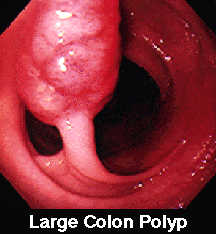..
Your doctor may have recommended that you undergo a special examination of your colon called Flexible Sigmoidoscopy, commonly called a "flex sig" Since your cooperation is essential for a successful and complete examination, it is important that you know exactly what is to be done and why. If, after reading this information, you have any additional questions concerning this procedure, ask your doctor.
..
 What Is Flexible Sigmoidoscopy?
What Is Flexible Sigmoidoscopy?In the past, you may have experienced or heard of a proctoscope examination of the lower colon and rectum. This was performed with a short rigid hollow tube which allowed your doctor to examine only the last 10 inches of the large intestine. This device was often painful and, unfortunately, gave colon checkups a bad reputation as a very uncomfortable and embarrassing examination. Fortunately, recent progress in the field of fiberoptics has made colon exams much easier and more accurate. A new device, called a flexible sigmoidoscope, a 24 inch long thin flexible tube which contains a tiny color video camera is now used. This allows your doctor to perform a much more accurate and comfortable examination than the old "procto."
..
Why Do I Need This Test?
Flexible sigmoidoscopy can be done for a number of reasons, but the most common one is to help prevent colon cancer. It is now known that most colon cancers begin many years before as a small noncancerous growth called a polyp. But unfortunately, polyps cause no symptoms until they develop into colon cancer and by then it is too late. To minimize your personal risk of colon cancer, your colon must be periodically examined - just as one has periodic mammograms and prostate checkups. If a polyp is found during this exam and later removed, a potential colon cancer can be prevented. In other circumstances, flexible sigmoidoscopy can also be done to examine the left colon for signs of colitis, or to further evaluate symptoms such as diarrhea and rectal bleeding.
..
Is This Test Dangerous?
There is some risk to any medical procedure, but the frequency of serious complications during flexible sigmoidoscopy is quite low. When performed by an experienced physician, the benefits far exceed the risks. The combination of your doctor's experience and your cooperation should make this test as safe and simple as possible. However, as with all medical procedures, complications can occur. The principal risks are perforation of the colon (a tear through the bowel wall) or bleeding. A perforation usually requires surgery but may be managed with antibiotics and intravenous fluids in selected cases. Bleeding from flexible sigmoidoscopy is usually minor and stops on its own or can be controlled with treatment. Occasionally, blood transfusions and surgery are necessary. Fortunately, both of these problems are quite rare during flexible sigmoidoscopy - about 1 case in 8000 for perforation and 1 case in 17,000 for bleeding.
..
Scope Disinfection
With all the attention that AIDS and Hepatitis C have had in the media, some individuals have been concerned that they might contract a disease from these examinations. Be assured that this is not the case. All of the instruments are extensively cleaned and completely disinfected between each case with techniques that have been shown to effectively kill disease-causing bacteria and viruses including those which cause AIDS and hepatitis.
..
How Do I Prepare For The Exam?
Your cooperation is essential for a successful and complete examination. There are certain things you can do to help before the test begins. Your colon must be empty during flexible sigmoidoscopy so that your doctor's view is not blocked by particles of stool. This will require a special dietary and laxative preparation the day before the test. Detailed preparation instructions will be provided by the office staff. Be sure your doctor knows if you are taking insulin injections or Coumadin anticoagulants. Unless otherwise instructed, you may take all of your other routine medications as usual, even the day of the exam. Since anesthesia is not needed, a driver is not required.
..
Looking Inside
On the day of examination, wear comfortable easily-folded clothing that is simple to remove. Prior to the test, you will be asked to remove your clothing and to slip into a patient gown. Then, after a consent form is signed, you will be positioned comfortably on your left side on the padded examination table. The doctor will then do a rectal exam with a gloved, lubricated finger; then the lubricated scope will be gently inserted. This will not be painful, but is mildly uncomfortable for a few seconds. After the scope is positioned, the doctor will gently guide the flexible scope into the colon and examine the lining. To improve his view, your doctor will gently infuse air into the colon. This may cause a temporary sensation of abdominal fullness, cramping, or "gas," but the entire procedure should take less than three minutes. After The Test After the exam, you will be allowed to dress and have a glass of juice. The doctor will then explain to you exactly what was found and if any further tests or treatment will be necessary. Since this test does not require anesthesia, you will be able to immediately resume a regular diet and activities. Eat lightly at first, and then advance your diet as tolerated. Since air was placed in the colon during the examination, you may feel a little bloated and crampy until the extra air is expelled.
..
 What If The Test Is Abnormal?
What If The Test Is Abnormal?Don't panic. If a polyp is found, it is unlikely to be cancer - most are not. As a plus, most colon polyps can now be removed without the need for major abdominal surgery through a simple outpatient surgical procedure called colonoscopy. This more extensive "scope" examination is usually painless and does not require hospitalization. Most patients are back to work in a day or two. If more serious problems are found, the doctor will explain what medical or surgical forms of treatment are available.
..
What If The Test Is Normal?
Of course, since the flexible sigmoidoscope is only 2 feet long and the average colon is 5 feet long, not all of the colon is examined during this procedure. But, flexible sigmoidoscopy does allow examination of the area where the majority of colon cancer, polyps, and other problems are found. You must realize that this test is a simple screening exam and it is possible that problems further inside the colon may be missed. However, if you are in a low risk group, have no family history of colon cancer, no symptoms, nor signs of blood in the stool, the latest American Cancer Society guidelines merely recommend another flexible sigmoidoscopy every five years in the future and a stool test for hidden blood, or Hemoccult slide test, annually. However if you have symptoms or are in a higher risk group, your doctor may wish to alter these guidelines to your particular case. In Summary So as you have learned, flexible sigmoidoscopy is a safe, simple, and highly effective diagnostic technique that allows your doctor to directly inspect the lining of your left colon. As an individual, you can dramatically reduce your risk of getting colon cancer by having regular examinations before symptoms develop. If you are over 50 years old, consult with your family physician about periodic colon examinations. Prevention means taking charge of your health. Following these few simple steps can keep you healthy to enjoy the good life you have worked so hard to create. It's worth the effort....
..
To view information on another disease, click on Pancreatitis SOD Library.!
..

No comments:
Post a Comment